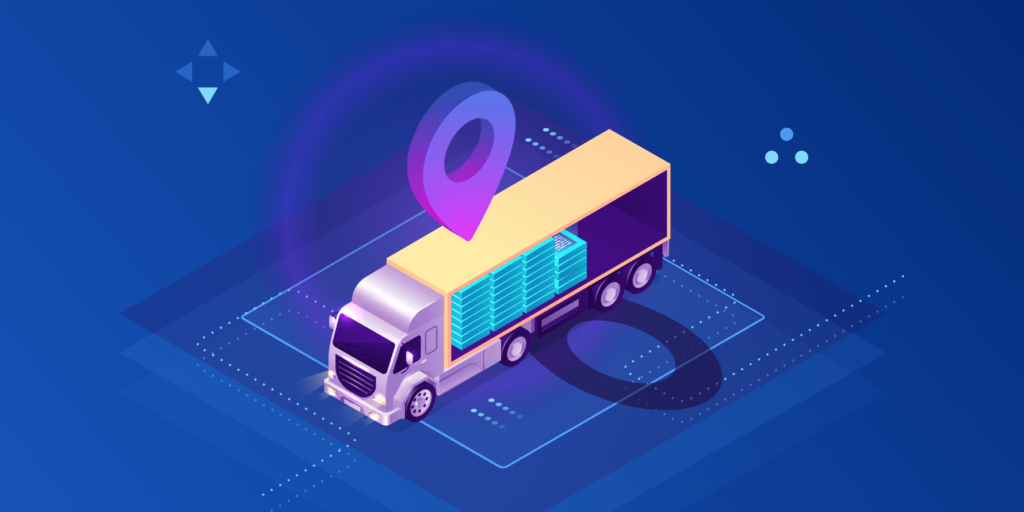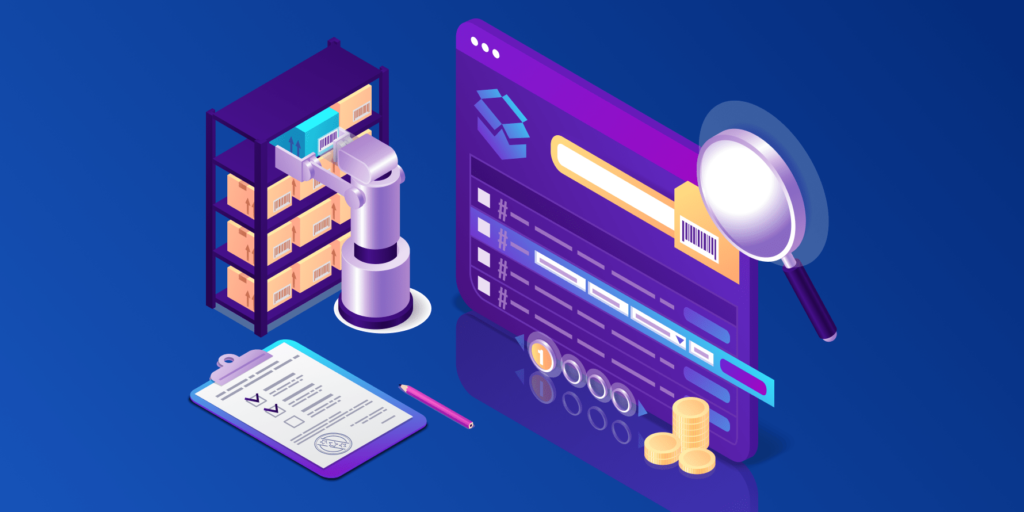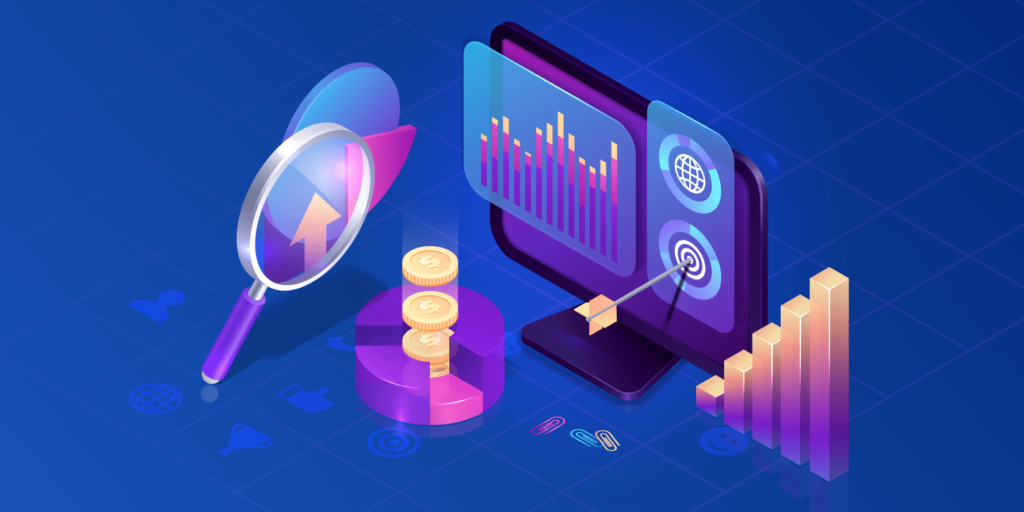Table of Contents
For a while, the logistics industry was labelled as unwilling to adopt digitization, but in recent years, it has been successfully embracing digital transformation initiatives. And while digitization in logistics is still extremely varied, companies operating in the industry start acknowledging the importance of deploying advanced technologies that bring scalability and automation.
A prime example of such technologies are logistics management systems. Whether you already thought about implementing an LMS or have not yet considered it, our article will explain why it’s important and how to do it properly.
What is a logistics management system?
We can define a logistics management system (LMS) as software that covers all processes related to the supply chain management and helps organizations transfer and store their goods efficiently.
When talking about logistics, keep in mind that it can be:
- Inbound: the goods are moved from a supplier to a warehouse and then to a production facility.
- Outbound: finished products are shipped to end customers from the warehouse.
One more thing to remember about logistics is that it can be forward and reverse. Forward logistics includes such processes as order management, preparation of the inventory, item shipping, etc. Reverse logistics includes all processes related to order returns, management of damaged/incorrect shipments, and item recycling.
The key benefits of a logistics management system
The key objective of an LMS is to bring clarity, speed, and automation to an organization. Thus, this system serves as a centralized platform for all operations involved in order fulfillment. Now, let’s look at the main advantages of having a good LMS in place.
Increased efficiency (and reduced costs)
With an LMS, organizations can receive a comprehensive overview of their operations, speed up the majority of processes (i.e., case picking), and better manage their inventory, thus avoiding surplus. This, in turn, leads to reduced operating costs and better efficiency of processes, since everything is done exactly when and as needed. An example would be warehouse management: an LMS allows smart resource allocation, depending on the volume of orders, and allows you to immediately learn whether anything calls for your attention.
Increased profitability
A logistics management system can help companies increase revenue in several ways. First, by cutting down operating costs through smart transportation and inventory management. Second, by increasing user satisfaction through improved order processing and higher order fulfillment rate. All that can help you save funds without sacrificing the quality or speed of services.
Improved tracking
Due to multiple modules included in an LMS, you can track your assets and orders at every stage, from warehouse to their delivery to end users. Due to the use of innovative technologies, which often include IoT and Artificial Intelligence, the order tracking process becomes smarter and safer. So by using an LMS, you will be able to always know and track any asset or order, from it being in a warehouse to the last mile logistics.

Smarter route planning
Due to the use of specialized route planning tools, an LMS helps organizations better plan their delivery routes and avoid traffic jamsor delivery delays. No need to say that the use of technology for route planning brings multiple benefits, such as faster delivery, increased customer satisfaction, and reduced costs.
The main components of an efficient logistics management system
Since supply chain management involve numerous operations, it’s natural that a logistics management system consists ofseveral modules, each dedicated to a specific stage of the supply chain. Let’s take a look at each in detail.
Order management
The core component of the whole supply chain is order placement, since without orders, there will be no need for other operations. T his module involves several processes, such as:
- Inventory revision
- Customer support
- Document flow management
- Processing of information from sales representatives
- Fraud detection
- Payment management
This module is also integrated with the CRM, so the information flows seamlessly between departments and allows seeing where the orders come from, analyzing customer behavior, and predicting future demand. The OMS module serves as a centralized hub for order processing and provides detailed information on all aspects of an order, such as its status, delivery time, etc. Also, this module processes payments and thus involves numerous accounting activities, most of which (i.e., generation of reports) are conveniently automated.
Inventory and warehouse management
Next comes inventory management, aka the management of your assets and goods. With an IMS, you are able to monitor and control the amount of products for sale, timely replenish your supplies, and effectively manage any changes in the inventory.
An inventory management system covers all possible types of goods that one might have. These goods are usually divided into 4 categories:
- Raw materials: items that are needed for the production of a product. An example of a raw material would be fabric and clothes would be a ready product, correspondingly.
- WIP inventory: WIP stands for work-in-progress and includes those items that are not yet ready for sale. If we continue with the clothing example, a WIP item would be a dress without buttons.
- MRO items: MRO means maintenance and repair and includes those items that are used in the manufacturing process but are not for sale (with this exact manufacturer).
- Finished products: implies goods that are ready for sale.

A good IMS covers all these categories of goods and can help you not only effectively manage them but also avoid overstocking, unorganized space, and disconnected data.
Warehouse management
In some LMS systems, inventory and warehouse management are united but here, we will talk about them separately. Warehouse management involves the following processes:
- Flow of goods
- Management of storage capacity
- Movement of items around the warehouse
- Management of warehouse employees
- Barcode tracking
- Creation of safe working conditions
As you can see, inventory is part of the warehouse management, though inventory can be managed separately. As for the WMS, its main functions are:
- Design : the warehouse management system usually has a 3D map that is used for more accurate inventory management, allocation of resources, and organization of workflows within the warehouse.
- Item picking : through smart barcode scanning, a WMS enables employees to quickly find the needed items and follow a short and optimized picking route, thus saving their time.
- Employee management : the WMS allows businesses to track the performance of their employees, monitor their workload, automatically schedule shifts, and more. It therefore takes just a few clicks to see a full history of one’s activity and identify ways to boost productivity.
Transport management
In some logistics management systems, the transport management module includes both transport and shipment management, so below, we will discuss both processes together. Hence, this module helps organizations with the following functions:
- Selection of the shipping method: the system will automatically choose the most fitting shipment method based on the nature of products (for instance, the ones that need a refrigerator), size of the order, etc.
- Integration with carriers: if you are using 3PL (third-party logistics), you will need to effectively connect with the carrier (or carriers) so all the data on the order is centralized and visible both to you and the carrier.
- Documentation: the system can automatically generate all needed documents and send them to needed parties to sign.
- Delivery scheduling: while customers can select the preferable delivery time, the system will also be able to calculate it based on the predictive traffic density, vehicle availability and type, etc. As well, the system provides order tracking so both you and the customer know where the order is at a specific time.
- Cross-docking: not a necessary feature for everyone, but might be included in your logistics management system. If you need to handle cross-docking, an LMS will help you retain control over the inventory and orders.
As you can see, this module allows companies to view their orders and their transportation process 24/7 while seamlessly handling documentation and providing transparent order tracking for customers.
Analytics and reporting
Considering the volumes of collected and processed data, it’s natural that an effective LMS has an analytics module. And while the data is analyzed at every stage of the supply chain, there is still a separate module that visualizes the needed data in an intuitive manner and allows you to instantly access it. Moreover, this module often contains Business Intelligence, which is specialized software used specifically for business data analysis.
Reports that are handled by the BI tools normally include:
- KPIs;
- Repair costs;
- Transportation costs;
- Analysis of trends;
- Carriers’ reports.
And much more. With an analytics module, organizations get a holistic view of their business and all operations and make data-driven decisions without any guesswork. This, in turn, positively impacts profitability as it allows cutting down unnecessary spendings and better organizing internal and external workflows.
Reverse logistics
Finally, a great LMS features a reverse logistics module, dedicated to managing returns (or items for recycling). And since these items are sent back to a manufacturer , they require a whole different management process than the goods that are up for shipping.
A standard reverse logistics module usually assists with :
- Information management: it is critical to collect such information as the reason for return, the item status (whether it was replaced, when it was returned, etc.), and similar in order to prevent potential returns in the future and be aware of what might drive customers away.
- Communication with customers: there is nothing more annoying than not knowing the status of an order, especially when it’s a return. The reverse logistics module typically allows clients to access the order status, monitor its delivery and replacement, and get in touch with the manufacturer. As well, the module enables manufacturers to automatically provide feedback to customers via the preferred method of communication.
- Quality assurance: if the reason for the return was low product quality, the system can automatically fill in the information and alert all involved parties (i.e., suppliers). It thus becomes easier to monitor quality assurance activities and immediately take action in case anything goes wrong.
Types of logistics management solutions
After we’ve looked at the main modules of an LMS, let’s talk about the main types of these systems. We’ll discuss various systems based on their hosting types and on implementation methods.
On-premises vs. cloud-based solutions
An on-premise LMS is hosted by your organization or by its provider on a physical server. A cloud solution, as the name implies, is hosted in the cloud and has now become widely popular with businesses in the logistics industry.
- On-premises LMS: the biggest advantage is its customization, especially if you designed the solution and know your way around the code. Also, it might be easier to implement updates and maintain the solution since you are the one in control. As for the price, with on-premise solutions you pay only once when purchasing/developing it (the fee might include installation, activation, etc. – check the details with the vendor).
- Cloud LMS: these solutions are highly portable, secure, and accessible. However, remember that they are fully managed by the vendor, so you won’t have control over implementing updates or adjusting functionality. As well, for cloud systems you usually pay a monthly fee so it might turn out quite costly in the long run.
Ready-made vs custom LMS
Next, you will need to choose between a ready-made or a custom LMS. A ready-made system is the one that was already developed by a vendor and is available for purchase. For example, it can be an LMS from your ERP provider. A custom LMS, on the other hand, is fully developed by your (or outsourced) development team and you fully own it.
The biggest advantage of a custom LMS is its near-endless flexibility and scalability. On the other hand, its development certainly takes some time and might be quite expensive. A ready-made solution is thus immediately available and is usually cheaper than a custom one.
A word on 3PLs
A 3PL stands for third-party logistics, and a 3PL provider handles a number of logistics operations. It can be a single service or a bunch of them, but the main point is that a company outsources its logistics (to a certain extent or fully).
Same as a ready-made LMS solution, you will need to integrate 3PL with your existing system, so all processes function seamlessly and the data exchange flow is uninterrupted. Depending on the system of choice, there are several integration options to consider:
- Via Electronic Data Interchange (EDI);
- Via API;
- Via non-EDI format files (i.e., JSON, CVS, etc.).
You will need to consult your 3PL provider to select the appropriate option and see what will make the most sense for your business.
As for the question on what LMS type to choose, the answer will solely depend on your specific business objectives and budget. We therefore recommend you outlining the desired deliverables, must-have features of an LMS, and available tech resources and expertise. Based on that, you will be able to clearly define what exact solution meets your needs.
How to implement logistics management solutions
We now move on to the question on how to actually implement an LMS, not only in terms of connecting it with your existing services but starting from scratch. We’ve briefly talked about how to select the right LMS type – now let’s dive in a bit more detail.
Define your goals and needs

As we already mentioned above, in order to choose a suitable logistic management solution, you first need to understand why you actually need it. It’s super important to set tangible goals and clear KPIs to achieve, so you can measure the success of the LMS implementation later on.
Maybe you just need to automate several processes and thus, the implementation of a logistics management system is not really necessary. Or maybe you need to gain better control over your inventory and warehousing, but don’t need all the modules that an LMS has. Whatever your business need it, clearly outline it and then match to available LMS solutions and their features.
Select the LMS type
Once you decide what you are looking for in an LMS, you will have to decide what type of system you need. When choosing between on-premise and cloud and between custom and ready-made, once again evaluate your budget, available resources, and whether you want to be fully responsible for the product and own it or you’d rather delegate its management to a third-party vendor.
A few tips on selecting the right logistic management software vendor (if you decide to outsource LMS development):
- Check vendor’s expertise and portfolio in the sphere of logistics;
- Do not hesitate to reach out to the vendor’s clients and ask them for testimonials;
- Schedule an introductory call with the team;
- Check the vendor on such websites like Clutch to see reviews and ratings.
If a company already has experience in designing software solutions similar to yours, it will be a great advantage as the development process will go faster and smoother and the team will know what exactly works for your specific domain.
Take care of needed integrations
Whether you are building a system from scratch or are deploying an available solution, you will have to think of integrating it with all needed components and services. Examples include:
- Cloud storage: if you are using a cloud platform, it will instantly boost your processes and will add scalability and speed to them. Most big LMS solutions can be easily integrated with such providers as Amazon or Google so you won’t have to worry about the efficiency of your integrated logistics management system.
- Payment gateways: a good logistics management system takes care of a bunch of accounting processes and naturally, you will manage payments both from clients and partners. Hence, you will need to integrate a secure payment gateway to seamlessly manage various payment types.
- Third-party services: if you use any third-party services, you will have to integrate them with your LMS of choice in order to maintain a holistic digital environment and ensure a seamless flow of data. Hence, you will have to request your team to develop sufficient APIs to connect the LMS with all needed services.
Provide employee training
A shift to a new logistics management system software is never easy and thus, you will have to provide training to your employees in order for them to quickly learn about the system and effectively manage it without causing any downtimes. Depending on the system’s complexity, you can choose from various training formats, from simple video guides to more comprehensive software training solutions. And keep in mind all user groups that are to interact with the LMS – all of them need to understand how to use it. Hence, the training may be required for other users outside your company.
The main challenges of LMS implementation
We’ve talked a lot about the value of an LMS solution – but it’s also important to mention the main challenges that one may face during its implementation.
Data security
An LMS is a software solution and, just like any other software, it might be prone to cyber attacks. And even the smallest data breach may result in critical financial losses and the loss of trust from your clients and partners. Hence, when implementing an LMS, it’s critical that you take care of your cybersecurity and ensure robust protection of both the system and your overall digital environment.

If you don’t know where to start, we highly recommend getting acquainted with the CIS security controls that vary, depending on the organization’s size and available resources. Or you can follow the ISO 27001 (or other standard) security framework to make sure that all aspects of your business are protected from potential threats.
Talent and skill gaps
Many great LMS solutions utilize advanced technologies like Artificial Intelligence and are quite complex. Hence, they require knowledgeable management and a certain level of skill and knowledge from your employees. And this may come as a challenge to some organizations that lack the needed talents and cannot provide sufficient training.
When deploying an LMS, it is important to remember that you have to train users to use the system as intended. If you don’t have enough people to work with the system, lack certain resources (not necessarily tech), or have not yet planned what kind of training you will provide, you might want to resolve these issues first before setting up an LMS.
Regulatory and compliance issues
When implementing an LMS, one should keep in mind certain regulations and compliance management processes (such as data protection or employment law). The main challenges here come from the fact that an organization most often works with suppliers and vendors from different countries, and each country has its own legal regulations. Hence, one has to consider:
- Variability of local regulations;
- Special aspects of international trade;
- Proper data management and accounting;
- Constantly updated regulations.
Conclusion
Logistics management systems are a highly valuable asset that can skyrocket one’s operations and bring an impressive increase in revenue and customer satisfaction. And considering how quickly logistics adopts innovative technologies, no wonder that modern logistics management solutions come equipped with Business Intelligence or AI. But before adopting such a solution, it is important to prepare your organization for the upcoming implementation and ensure that it will not disrupt your current workflow. With extensive experience in serving the logistics industry, we at SoftTeco highly recommend consulting a reliable vendor on how to best implement an LMS and what system will work best for your business.


Comments